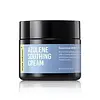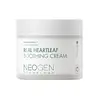What's inside
What's inside
 Key Ingredients
Key Ingredients

 Benefits
Benefits

 Concerns
Concerns

No concerns
 Ingredients Side-by-side
Ingredients Side-by-side

Water
Skin ConditioningButylene Glycol
HumectantCetyl Ethylhexanoate
Emollient1,2-Hexanediol
Skin ConditioningPolysorbate 60
EmulsifyingGlycerin
HumectantCaprylic/Capric Triglyceride
MaskingCoco-Caprylate/Caprate
EmollientGuaiazulene
AntimicrobialCentella Asiatica Extract
CleansingAsiaticoside
AntioxidantMadecassic Acid
Skin ConditioningAsiatic Acid
Skin ConditioningMadecassoside
AntioxidantPolyacrylate-13
Cetyl Alcohol
EmollientStearyl Alcohol
EmollientAcrylates/C10-30 Alkyl Acrylate Crosspolymer
Emulsion StabilisingPolyisobutene
Glyceryl Stearate
EmollientBeeswax
Emulsion StabilisingTromethamine
BufferingPalmitic Acid
EmollientStearic Acid
CleansingXanthan Gum
EmulsifyingPolysorbate 20
EmulsifyingEthylhexylglycerin
Skin ConditioningSorbitan Isostearate
EmulsifyingAdenosine
Skin ConditioningSodium Hyaluronate
HumectantAllantoin
Skin ConditioningPanthenol
Skin ConditioningOenothera Biennis Oil
EmollientCeramide NP
Skin ConditioningPersea Gratissima Oil
Skin ConditioningCalamine
AbsorbentMelaleuca Alternifolia Leaf Oil
AntioxidantSimmondsia Chinensis Seed Oil
EmollientCupressus Sempervirens Oil
MaskingButyrospermum Parkii Butter
Skin ConditioningBetula Platyphylla Japonica Juice
Skin ConditioningGlycyrrhiza Glabra Root Extract
BleachingPropanediol
SolventCamellia Japonica Flower Extract
EmollientAloe Barbadensis Leaf Extract
EmollientCalendula Officinalis Extract
Skin ConditioningChamomilla Recutita Extract
Skin ConditioningMentha Rotundifolia Leaf Extract
TonicLavandula Angustifolia Flower Extract
CleansingCitric Acid
BufferingDisodium EDTA
Water, Butylene Glycol, Cetyl Ethylhexanoate, 1,2-Hexanediol, Polysorbate 60, Glycerin, Caprylic/Capric Triglyceride, Coco-Caprylate/Caprate, Guaiazulene, Centella Asiatica Extract, Asiaticoside, Madecassic Acid, Asiatic Acid, Madecassoside, Polyacrylate-13, Cetyl Alcohol, Stearyl Alcohol, Acrylates/C10-30 Alkyl Acrylate Crosspolymer, Polyisobutene, Glyceryl Stearate, Beeswax, Tromethamine, Palmitic Acid, Stearic Acid, Xanthan Gum, Polysorbate 20, Ethylhexylglycerin, Sorbitan Isostearate, Adenosine, Sodium Hyaluronate, Allantoin, Panthenol, Oenothera Biennis Oil, Ceramide NP, Persea Gratissima Oil, Calamine, Melaleuca Alternifolia Leaf Oil, Simmondsia Chinensis Seed Oil, Cupressus Sempervirens Oil, Butyrospermum Parkii Butter, Betula Platyphylla Japonica Juice, Glycyrrhiza Glabra Root Extract, Propanediol, Camellia Japonica Flower Extract, Aloe Barbadensis Leaf Extract, Calendula Officinalis Extract, Chamomilla Recutita Extract, Mentha Rotundifolia Leaf Extract, Lavandula Angustifolia Flower Extract, Citric Acid, Disodium EDTA
Houttuynia Cordata Water 75%
MaskingGlycerin
HumectantPropanediol
SolventButylene Glycol
Humectant1,2-Hexanediol
Skin ConditioningNiacinamide
SmoothingMethyl Trimethicone
Skin ConditioningCetyl Ethylhexanoate
EmollientOlea Europaea Fruit Oil
MaskingPanthenol
Skin ConditioningArginine
MaskingCetearyl Olivate
Acrylates/C10-30 Alkyl Acrylate Crosspolymer
Emulsion StabilisingCetyl Alcohol
EmollientStearyl Alcohol
EmollientSorbitan Olivate
EmulsifyingCarbomer
Emulsion StabilisingBetaine
HumectantEthylhexylglycerin
Skin ConditioningAdenosine
Skin ConditioningCalcium Disodium EDTA
Pyrus Communis Fruit Extract
Skin ConditioningHedera Helix Leaf/Stem Extract
AntimicrobialPyrus Malus Fruit Extract
Skin ConditioningFragaria Chiloensis Fruit Extract
Skin ConditioningWater
Skin ConditioningGuaiazulene
AntimicrobialMacadamia Integrifolia Seed Oil
Skin ConditioningCentella Asiatica Extract
CleansingXanthan Gum
EmulsifyingCalendula Officinalis Extract
Skin ConditioningArtemisia Capillaris Extract
Caprylyl Glycol
EmollientGlucose
HumectantSodium Hyaluronate
HumectantChondrus Crispus Extract
Skin ConditioningHydroxypropyltrimonium Hyaluronate
Hydrolyzed Hyaluronic Acid
HumectantSodium Acetylated Hyaluronate
HumectantHyaluronic Acid
HumectantSodium Hyaluronate Crosspolymer
HumectantHydrolyzed Sodium Hyaluronate
Skin ConditioningPotassium Hyaluronate
Skin ConditioningHouttuynia Cordata Water 75%, Glycerin, Propanediol, Butylene Glycol, 1,2-Hexanediol, Niacinamide, Methyl Trimethicone, Cetyl Ethylhexanoate, Olea Europaea Fruit Oil, Panthenol, Arginine, Cetearyl Olivate, Acrylates/C10-30 Alkyl Acrylate Crosspolymer, Cetyl Alcohol, Stearyl Alcohol, Sorbitan Olivate, Carbomer, Betaine, Ethylhexylglycerin, Adenosine, Calcium Disodium EDTA, Pyrus Communis Fruit Extract, Hedera Helix Leaf/Stem Extract, Pyrus Malus Fruit Extract, Fragaria Chiloensis Fruit Extract, Water, Guaiazulene, Macadamia Integrifolia Seed Oil, Centella Asiatica Extract, Xanthan Gum, Calendula Officinalis Extract, Artemisia Capillaris Extract, Caprylyl Glycol, Glucose, Sodium Hyaluronate, Chondrus Crispus Extract, Hydroxypropyltrimonium Hyaluronate, Hydrolyzed Hyaluronic Acid, Sodium Acetylated Hyaluronate, Hyaluronic Acid, Sodium Hyaluronate Crosspolymer, Hydrolyzed Sodium Hyaluronate, Potassium Hyaluronate
Ingredients Explained
These ingredients are found in both products.
Ingredients higher up in an ingredient list are typically present in a larger amount.
1,2-Hexanediol is a synthetic liquid and another multi-functional powerhouse.
It is a:
- Humectant, drawing moisture into the skin
- Emollient, helping to soften skin
- Solvent, dispersing and stabilizing formulas
- Preservative booster, enhancing the antimicrobial activity of other preservatives
Acrylates/C10-30 Alkyl Acrylate Crosspolymer is a synthetic polymer. It is used to thicken and improve the texture of products. Due to its properties, it can prevent water and oil ingredients from separating.
Adenosine is in every living organism. It is one of four components in nucleic acids that helps store our DNA.
Adenosine has many benefits when used. These benefits include hydrating the skin, smoothing skin, and reducing wrinkles. Once applied, adenosine increases collagen production. It also helps with improving firmness and tissue repair.
Studies have found adenosine may also help with wound healing.
In skincare products, Adenosine is usually derived from yeast.
Learn more about AdenosineButylene Glycol (or BG) is used within cosmetic products for a few different reasons:
Overall, Butylene Glycol is a safe and well-rounded ingredient that works well with other ingredients.
Though this ingredient works well with most skin types, some people with sensitive skin may experience a reaction such as allergic rashes, closed comedones, or itchiness.
Learn more about Butylene GlycolCalendula Officinalis Extract comes from the common Marigold plant.
Marigold flowers contain flavonoids. Flavonoids are a group of substances found naturally in plants. They possess antioxidant and inflammation properties.
This ingredient may help soothe your skin by reducing inflammation. Emerging studies show it inhibits nitrous oxide production safely, therefore reducing inflammation.
Marigolds have been used in traditional medicine throughout Asia and Europe.
Learn more about Calendula Officinalis ExtractCentella Asiatica Extract (Centella) is derived from an herb native to Southeast Asia. It is famous for its anti-inflammatory and soothing properties.
Centella is rich in antioxidants and amino acids, such as Madecassic Acid and Asiaticoside.
Studies show the compounds in centella help with:
The combination of all these properties makes centella effective at soothing, hydrating, and protecting the skin.
Other great components of centella include Vitamin A, vitamin C, several B vitamins, and Asiatic Acid.
Fun fact: Centella has been used as a medicine and in food for many centuries. As a medicine, it is used to treat burns, scratches, and wounds.
Learn more about Centella Asiatica ExtractCetyl Alcohol is a fatty alcohol. Fatty Alcohols are most often used as an emollient or to thicken a product.
Its main roles are:
Though it has "alcohol" in the name, it is not related to denatured alcohol or ethyl alcohol.
The FDA allows products labeled "alcohol-free" to have fatty alcohols.
Learn more about Cetyl AlcoholCetyl Ethylhexanoate is an emollient ester. It comes from cetearyl alcohol and 2-ethylhexanoic acid.
Cetyl Ethylhexanoate is an emollient that adds a velvety feel to skin without being greasy or oily. Emollients help trap moisture into your skin, keeping your skin soft and hydrated.
Ethylhexylglycerin (we can't pronounce this either) is commonly used as a preservative and skin softener. It is derived from glyceryl.
You might see Ethylhexylglycerin often paired with other preservatives such as phenoxyethanol. Ethylhexylglycerin has been found to increase the effectiveness of these other preservatives.
Glycerin is already naturally found in your skin. It helps moisturize and protect your skin.
A study from 2016 found glycerin to be more effective as a humectant than AHAs and hyaluronic acid.
As a humectant, it helps the skin stay hydrated by pulling moisture to your skin. The low molecular weight of glycerin allows it to pull moisture into the deeper layers of your skin.
Hydrated skin improves your skin barrier; Your skin barrier helps protect against irritants and bacteria.
Glycerin has also been found to have antimicrobial and antiviral properties. Due to these properties, glycerin is often used in wound and burn treatments.
In cosmetics, glycerin is usually derived from plants such as soybean or palm. However, it can also be sourced from animals, such as tallow or animal fat.
This ingredient is organic, colorless, odorless, and non-toxic.
Glycerin is the name for this ingredient in American English. British English uses Glycerol/Glycerine.
Learn more about GlycerinGuaiazulene is a fragrance.
Panthenol is a common ingredient that helps hydrate and soothe the skin. It is found naturally in our skin and hair.
There are two forms of panthenol: D and L.
D-panthenol is also known as dexpanthenol. Most cosmetics use dexpanthenol or a mixture of D and L-panthenol.
Panthenol is famous due to its ability to go deeper into the skin's layers. Using this ingredient has numerous pros (and no cons):
Like hyaluronic acid, panthenol is a humectant. Humectants are able to bind and hold large amounts of water to keep skin hydrated.
This ingredient works well for wound healing. It works by increasing tissue in the wound and helps close open wounds.
Once oxidized, panthenol converts to pantothenic acid. Panthothenic acid is found in all living cells.
This ingredient is also referred to as pro-vitamin B5.
Learn more about PanthenolPropanediol is an all-star ingredient. It softens, hydrates, and smooths the skin.
It’s often used to:
Propanediol is not likely to cause sensitivity and considered safe to use. It is derived from corn or petroleum with a clear color and no scent.
Learn more about PropanediolSodium Hyaluronate is hyaluronic acid's salt form. It is commonly derived from the sodium salt of hyaluronic acid.
Like hyaluronic acid, it is great at holding water and acts as a humectant. This makes it a great skin hydrating ingredient.
Sodium Hyaluronate is naturally occurring in our bodies and is mostly found in eye fluid and joints.
These are some other common types of Hyaluronic Acid:
Learn more about Sodium HyaluronateStearyl Alcohol is a type of fatty alcohol from stearic acid. It is a white, waxy compound used to emulsify ingredients.
Fatty Alcohols are most often used as an emollient or to thicken a product. Emollients help soothe and hydrate the skin by trapping moisture.
They are usually derived from natural fats and oils and therefore do not have the same drying or irritating effect as solvent alcohols. FDA allows products labeled "alcohol-free" to have fatty alcohols.
Learn more about Stearyl AlcoholWater. It's the most common cosmetic ingredient of all. You'll usually see it at the top of ingredient lists, meaning that it makes up the largest part of the product.
So why is it so popular? Water most often acts as a solvent - this means that it helps dissolve other ingredients into the formulation.
You'll also recognize water as that liquid we all need to stay alive. If you see this, drink a glass of water. Stay hydrated!
Learn more about WaterXanthan gum is used as a stabilizer and thickener within cosmetic products. It helps give products a sticky, thick feeling - preventing them from being too runny.
On the technical side of things, xanthan gum is a polysaccharide - a combination consisting of multiple sugar molecules bonded together.
Xanthan gum is a pretty common and great ingredient. It is a natural, non-toxic, non-irritating ingredient that is also commonly used in food products.
Learn more about Xanthan Gum